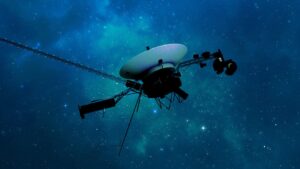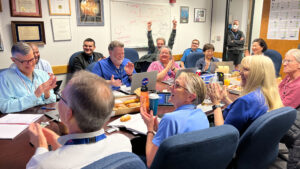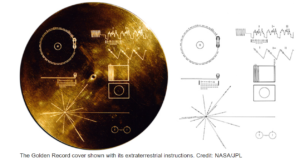Voyager 1 Back in Action Thanks to JPL Engineers
The plucky Voyager 1 spacecraft has another lease on life as it continues its voyage through interstellar space. The 46-year old spacecraft, billions of miles from home, began sending unintelligible data back to Earth in November, but engineers at the Jet Propulsion Laboratory figured out what was wrong and devised a remedy.
Launched in 1977, Voyager 1 flew past Jupiter and Saturn in 1979 and 1980 respectively and then headed out into the furthest reaches of our solar system. In 2012, it passed into interstellar space and now is 15 billion miles away. It takes almost a day — 22.5 hours — for a radio signal to make a one way trip.

On November 13, 2023, the science and engineering data Voyager 1 was sending back to JPL via the Deep Space Network suddenly became unreadable.
The Voyager 1 engineering team at JPL spent months diagnosing what was wrong and determined it was something to do with one of the three onboard computers, the Flight Data Subsystem (FDS) that packages data for transmission to Earth. In the end, it turned out a chip that stores part of the FDS memory malfunctioned. The loss of the FDS software code “rendered the science and engineering data unusable,” JPL explained.
The engineers were able to reconfigure the software to store that code elsewhere in the FDS memory.
“Unable to repair the chip, the team decided to place the affected code elsewhere in the FDS memory. But no single location is large enough to hold the section of code in its entirety.
“So they devised a plan to divide the affected code into sections and store those sections in different places in the FDS. To make this plan work, they also needed to adjust those code sections to ensure, for example, that they all still function as a whole. Any references to the location of that code in other parts of the FDS memory needed to be updated as well.” — JPL
They took the first step of sending the software code for engineering data to its new location in the FDS memory on April 18. With the two-day signal travel time, it was not until April 20 that the elated team knew their plan worked and they could finally check the spacecraft’s status for the first time in five months.

Now they are working on relocating the software code for the science data.
Voyager 1 and its sister Voyager 2, which also flew past Uranus and Neptune on its way into a different part of interstellar space, started off as planetary probes, but once they passed the planets they became heliophysics probes collecting data on the influence of the Sun at those distances. Voyager 2 entered interstellar space in November 2018 and now is 12.7 million miles from Earth.
They are the only spacecraft in interstellar space, the region beyond the heliopause where the Sun’s reach ends. The fields and particle instruments are still functioning and returning data.

Both spacecraft carry Golden Records with sights and sounds from Earth including greetings in 55 languages in case they are found by extraterrestrials. Renowned astronomer Carl Sagan chaired the committee that decided the contents of the 12-inch gold-plated records, which include instructions on how to play them.

NASA Deputy Administrator Pam Melroy was one of the many Voyager fans offering congratulations to the JPL team. Melroy not only is a former test pilot and astronaut, but has a bachelor’s degree in physics and astronomy from Wellesley and a master’s in Earth and planetary sciences from MIT.
Congratulations to the amazing @NASAJPL @NASAVoyager and Deep Space Network teams! Voyager inspired me as a student and I’m so glad we are back in touch. #Goingfor50 https://t.co/f2EkHVfaMv
— Pamela Melroy (@Astro_Pam) April 23, 2024
User Comments
SpacePolicyOnline.com has the right (but not the obligation) to monitor the comments and to remove any materials it deems inappropriate. We do not post comments that include links to other websites since we have no control over that content nor can we verify the security of such links.